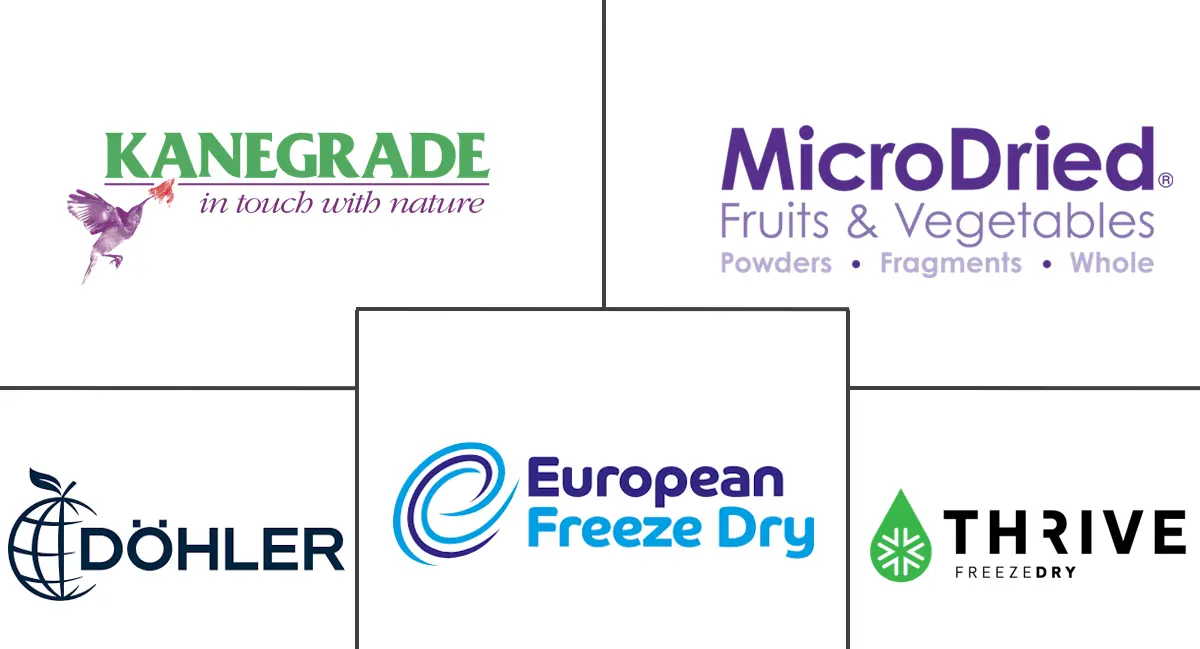Fruit Powder Market Size and Share

Fruit Powder Market Analysis by Mordor Intelligence
The fruit powder market is valued at USD 16.23 billion in 2025 and is projected to reach USD 22.01 billion by 2030, advancing at a 6.28% CAGR. This growth is largely driven by consumers' increasing preference for clean-label, shelf-stable ingredients. These ingredients not only simplify formulation processes but also enhance inventory management efficiency for food and beverage manufacturers. The demand remains broad-based, supported by the growing adoption of fruit powders in beverages, snacks, and nutraceuticals due to their versatility and health benefits. Additionally, technological advancements, particularly in ambient-temperature spray drying, have significantly reduced production costs while preserving essential nutrients, making the production process more efficient. Regulatory changes, especially the 2024 USDA Strengthening Organic Enforcement rule, are accelerating the penetration of certified-organic products in the market. These regulatory shifts favor processors with well-established compliance systems, enabling them to adapt more effectively. The competitive landscape remains intense, characterized by a fragmented market structure and substantial opportunities for innovation, including exotic fruit types, organic variants, and functional blends.
Key Report Takeaways
- By fruit type, banana powders led with 22.85% of fruit powder market share in 2024; dragon fruit is the fastest-growing at a 6.78% CAGR through 2030.
- By application, beverages accounted for 28.87% of the fruit powder market size in 2024, while snacks and ready-to-eat products expand the quickest at 7.21% CAGR to 2030.
- By category, the conventional segment controlled 88.05% of 2024 revenue; the organic segment posts an 8.33% CAGR, the highest among all categories.
- By geography, Asia-Pacific commanded 35.23% revenue share in 2024; Europe records the strongest regional CAGR at 7.21% to 2030.
Global Fruit Powder Market Trends and Insights
Drivers Impact Analysis
| Driver | (~) % Impact on CAGR Forecast | Geographic Relevance | Impact Timeline |
|---|---|---|---|
| Rising demand for convenience foods drives fruit powder usage | +1.2% | Global, concentrated in North America and Europe | Medium term (2-4 years) |
| Rising popularity of smoothies and health drinks enhances demand | +0.9% | North America, Europe, Asia-Pacific urban centers | Short term (≤ 2 years) |
| Growth of clean-label trends boosts natural ingredient demand | +1.5% | Europe, North America, spill-over to Asia-Pacific | Long term (≥ 4 years) |
| Longer shelf life encourages fruit powder adoption over fresh | +0.8% | Global, especially emerging markets | Medium term (2-4 years) |
| Rising demand from bakery and beverage manufacturers globally | +1.1% | Global, led by Asia-Pacific production hubs | Medium term (2-4 years) |
| Customizable formulations attract manufacturers seeking functional ingredients | +0.7% | North America, Europe | Long term (≥ 4 years) |
| Source: Mordor Intelligence | |||
Rising Demand for Convenience Foods Drives Fruit Powder Usage
Urbanization and a burgeoning middle class are driving a global surge in demand for processed and packaged foods, reshaping the role of fruit powders from mere flavoring agents to essential ingredients. Innovations in product offerings have made items like baked goods, confections, and beverages more appealing, leading to increased consumption. Young consumers and professionals are gravitating towards processed drinks, including cold and energy beverages. This shift presents a golden opportunity for fruit powder manufacturers to craft authentic taste profiles while adhering to clean label mandates, especially as consumers become more discerning about ingredient lists. Under the USDA's organic labeling guidelines, products must contain a minimum of 95% organic ingredients to bear the "organic" label, creating a lucrative avenue for certified fruit powder suppliers [1]Source: U.S. Department of Agriculture, "Organic-About the Organic Standards", www.ams.usda.gov. The momentum is further fueled by food service operators' demand for shelf-stable ingredients that ensure consistent flavor profiles throughout the seasons, streamlining procurement and cutting inventory management costs.
Rising Popularity of Smoothies and Health Drinks Enhances Demand
Fruit powders are becoming a staple in functional beverage formulations, enhancing nutritional density without sacrificing taste or texture. These powders are particularly valued for their ability to provide essential vitamins, minerals, and antioxidants, making them an ideal ingredient for health-conscious consumers. As the industry pivots towards plant-based meal replacements, the demand surges for fruit powders that offer both rich flavors and nutritional benefits in powdered beverages. This trend isn't limited to the usual smoothie bars; it's making waves in institutional food services and retail meal replacements. Here, fruit powders play a crucial role in ensuring consistent nutritional profiles, even in large-scale productions, while also catering to the growing consumer preference for clean-label products. Moreover, as the beverage industry embraces sustainable packaging, there's a clear preference for concentrated fruit powders over their liquid counterparts. This choice not only slashes transportation costs and carbon emissions but also boosts the product's shelf life, aligning with the industry's sustainability goals and operational efficiencies.
Growth of Clean Label Trends Boosts Natural Ingredient Demand
Regulatory pressures and consumer advocacy are driving a notable rise in the demand for transparent ingredient labeling. With consumers placing a premium on clean and natural products, fruit powders are stepping in as essential replacements for synthetic flavoring systems. The German Organic Food Association (BÖLW) reported that in 2024, Germany's organic food revenue hit EUR 16.99 billion [2]Source: German Organic Food Association (BÖLW), " Ökologische Lebensmittelwirtschaft - Branchenreport 2024", www.boelw.de. The FDA's heightened scrutiny on artificial additives in standardized food products is paving the way for natural fruit powder alternatives. This clean label movement isn't confined to consumer packaged goods; it's making waves in the food service sector as well. Operators in the food service industry are on the lookout for ingredients that resonate with health-conscious branding, striving to align with consumer expectations while juggling operational efficiency and cost management.
Longer Shelf Life Encourages Fruit Powder Adoption Over Fresh
The longer shelf life of fruit powder compared to fresh produce is a significant driver in the Fruit Powder Market. According to the United States Department of Agriculture (USDA), fruit powders can last up to 12-18 months when stored properly, whereas fresh fruits typically spoil within a few days to weeks. Additionally, the Food and Agriculture Organization (FAO) highlights that fruit powders reduce post-harvest losses, making them a sustainable alternative. These factors are encouraging manufacturers and consumers to adopt fruit powders over fresh produce. Furthermore, the European Food Safety Authority (EFSA) has emphasized the role of fruit powders in retaining essential nutrients, which often degrade in fresh fruits during transportation and storage. The Indian Council of Agricultural Research (ICAR) also reports that fruit powders are increasingly being used in food and beverage applications, such as smoothies, bakery products, and infant nutrition, due to their convenience and extended usability. This trend is further supported by government initiatives promoting food processing and value addition, such as India's Pradhan Mantri Kisan Sampada Yojana, which aims to reduce agricultural waste and enhance the shelf life of perishable goods.
Restraints Impact Analysis
| Restraint | (~) % Impact on CAGR Forecast | Geographic Relevance | Impact Timeline |
|---|---|---|---|
| Fluctuating raw material prices impact profit margins severely | -0.8% | Global, notably Asia-Pacific production regions | Short term (≤ 2 years) |
| Availability of synthetic flavors hampers natural product demand | -0.6% | Global, higher in price-sensitive markets | Medium term (2-4 years) |
| Quality variation among suppliers affects brand reputation | -0.5% | Global | Short term (≤ 2 years) |
| Dependence on seasonal fruit availability challenges continuous production | -0.7% | Asia-Pacific core, spill-over to Middle East and Africa | Medium term (2-4 years) |
| Source: Mordor Intelligence | |||
Fluctuating Raw Material Prices Impact Profit Margins Severely
Raw material price volatility significantly pressures margins across the fruit powder supply chain, with smaller processors facing the greatest impact due to limited hedging capabilities. Seasonal fruit availability patterns, such as the pronounced peaks and valleys in strawberry prices, force processors to either manage intricate inventory strategies or endure margin compression. This challenge becomes even more pronounced for specialty fruit powders, like dragon fruit, as restricted cultivation zones, weather dependencies, and limited global production create significant supply bottlenecks. Processing companies increasingly adopt vertical integration and long-term supply contracts to mitigate price volatility. However, these strategies require substantial capital investment, reduce operational flexibility, and often remain unfeasible for smaller players in the market.
Availability of Synthetic Flavors Hampers Natural Product Demand
Cost-conscious manufacturers actively rely on synthetic flavoring systems, even as clean label trends gain momentum. This reliance is particularly evident in product categories where consumers prioritize affordability over natural ingredients. The FDA has granted many synthetic flavor compounds the Generally Recognized as Safe (GRAS) status, providing manufacturers with regulatory certainty that natural alternatives often lack [3]Source: U.S. Food and Drug Administration, "Food Additives and GRAS Ingredients - Information for Consumers", www.fda.gov. This regulatory framework allows synthetic flavors to retain their market share in applications where maintaining flavor consistency and controlling costs outweigh the benefits of clean labels. Emerging markets face this challenge more acutely, as heightened price sensitivity restricts the adoption of premium natural ingredients. Consequently, these markets develop a two-tier structure, which constrains their overall growth potential by limiting the penetration of higher-value natural products.
Segment Analysis
By Fruit Type: Premium Exotic Varieties Capture Momentum
Banana powders commanded a dominant 22.85% share of the market in 2024, buoyed by dependable tropical supply chains and widespread consumer recognition. The global fruit powder market is characterized by its diverse applications across the food and beverage industries, including bakery, confectionery, beverages, and dietary supplements. While apple, citrus, and grape powders maintain their foothold in bakery glazes, confectionery fillings, and wine-related mixes, the market is increasingly gravitating towards exotic varieties. Leading the charge, dragon fruit boasts a premium growth rate of 6.78% CAGR, celebrated for its antioxidant properties and vibrant color, enhancing the visual allure of clean-label snacks.
With a global emphasis on wellness, berry powders, particularly blueberry and raspberry, are gaining traction, commanding premium prices due to their associated polyphenol benefits. The rising demand for natural and clean-label ingredients further drives the adoption of fruit powders in functional food and beverage formulations. In these niche segments, processors ensuring consistent seed-free milling and color preservation hold significant pricing leverage. Additionally, advancements in drying technologies, such as freeze-drying and spray-drying, are enabling manufacturers to retain the nutritional and sensory properties of fruit powders, further fueling market growth.
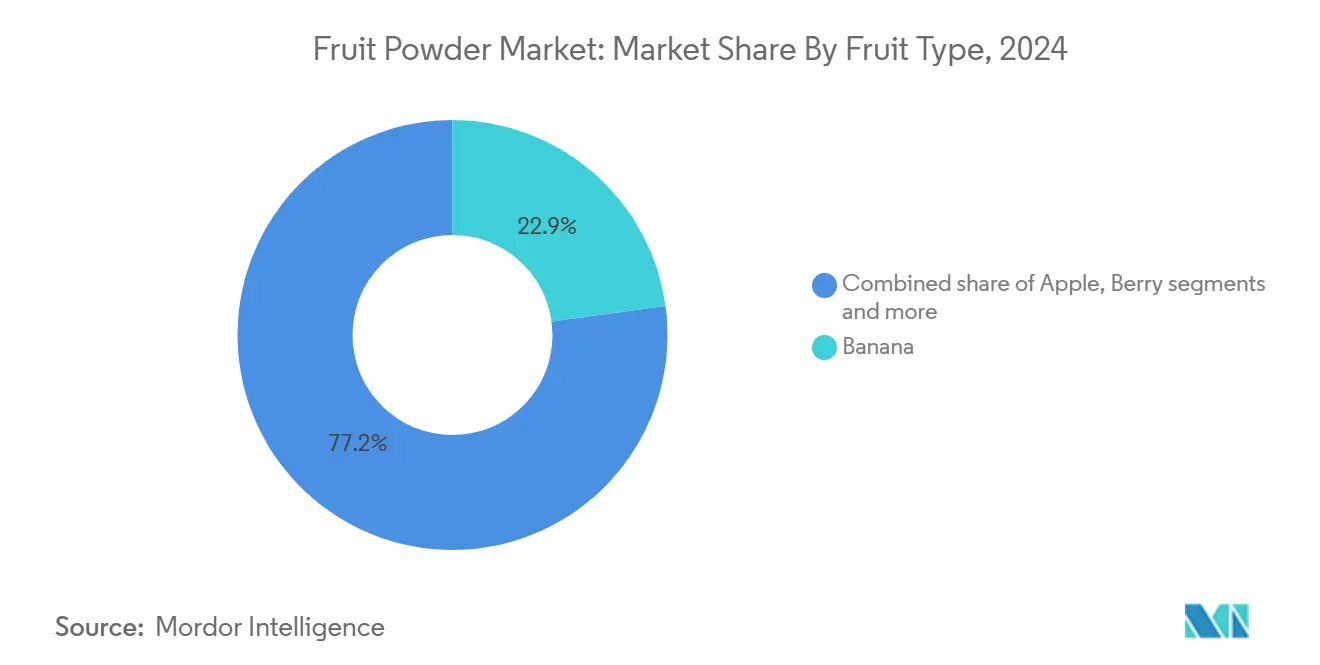
Note: Segment shares of all individual segments available upon report purchase
By Category: Certified-Organic Upshift Raises Entry Barriers
In 2024, conventional powders command a dominant 88.05% revenue share in the global fruit powder market, driven by cost-efficient supply chains and the broader availability of crops across regions. These powders remain a preferred choice for manufacturers due to their affordability, long shelf life, and ease of integration into various applications, such as beverages, bakery products, confectionery, dairy, and dietary supplements. The widespread use of conventional powders is also supported by their consistent quality and availability, making them a reliable option for large-scale production.
Meanwhile, organic variants are gaining significant traction, recording an 8.33% CAGR. This growth is fueled by increasing consumer demand for clean-label, chemical-free, and sustainably sourced products, which align with the rising awareness of health and environmental concerns. Retailers are responding to this trend by expanding certified SKU offerings, ensuring a wider variety of organic fruit powders are available to meet diverse consumer preferences. Additionally, stricter regulatory scrutiny on synthetic additives, pesticides, and other harmful chemicals further supports the adoption of organic fruit powders in the market. The organic segment is also benefiting from advancements in processing technologies, which help retain the nutritional value and natural flavor of the fruits, enhancing their appeal to health-conscious consumers.
By Application: Snacks Extend Growth Beyond Beverage Core
In 2024, beverages dominated the market, capturing 28.87% of the market share. This was largely attributed to the increasing demand from smoothie chains, sports-nutrition mixes, and ready-to-drink sachets, all of which prioritize soluble, naturally flavored inputs. The convenience and health-focused trends in the beverage industry have further fueled this demand, making fruit powders a preferred ingredient for manufacturers aiming to cater to evolving consumer preferences. However, snacks and ready-to-eat formats are emerging as high-growth segments, recording a robust 7.21% CAGR during the forecast period. These sectors effectively leverage fruit powders to deliver authentic fruit flavors in extruded cereals, bars, and trail mixes, while mitigating the risk of moisture-induced spoilage.
The growing consumer inclination toward on-the-go snacking and clean-label products has amplified the adoption of fruit powders in these applications. The bakery sector is also capitalizing on the versatility of fruit powders. These powders are increasingly used to enhance the stability of color and flavor in fillings, while simultaneously maintaining dough rheology. This ensures consistent product quality and appeals to consumers seeking visually appealing and flavorful baked goods. In the dairy industry, fruit powders are gaining traction as a key ingredient in frozen yogurts. Unlike fresh fruit pieces, which can fracture cell structures during the hardening process, fruit powders provide a stable alternative that preserves the texture and integrity of the final product. This makes them an ideal choice for dairy processors aiming to deliver high-quality frozen desserts.
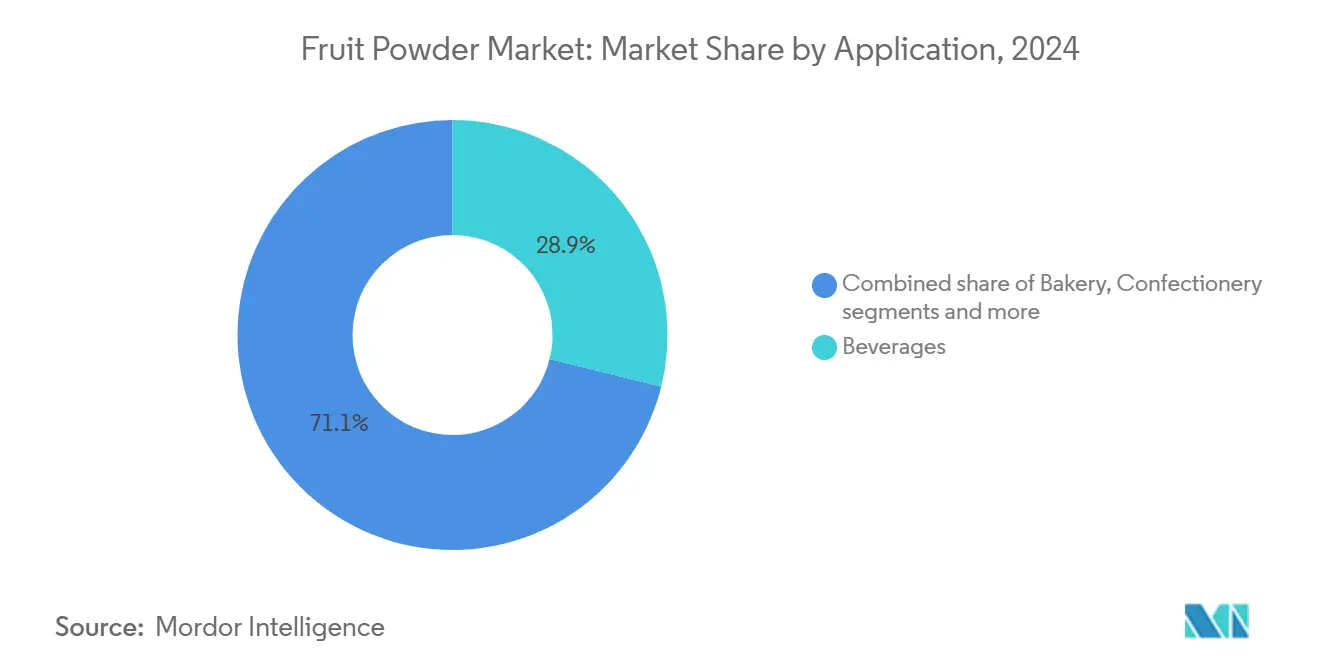
Note: Segment shares of all individual segments available upon report purchase
Geography Analysis
In 2024, Asia-Pacific commands a dominant 35.23% share of the market, a testament to decades of strategic investments in fruit processing and a focus on export-oriented production tailored for global food manufacturers. The region enjoys competitive edges, such as lower labor costs, a rich supply of raw materials, and well-established trade ties with major consumer markets. Additionally, the region's ability to scale production efficiently and adapt to evolving global demand has solidified its leadership position in the market.
Europe is on a growth trajectory, boasting a 7.21% CAGR through 2030. This momentum is fueled by regulatory frameworks that champion natural ingredients and premium positioning strategies, allowing for margins that outpace traditional commodity production. The region's focus on sustainability and innovation in product development further strengthens its competitive stance, as consumers increasingly prioritize high-quality, ethically sourced products.
North America is at the forefront of innovation, placing a strong emphasis on regulatory compliance. This is especially evident in areas like organic certification and clean label formulations, which resonate with today's consumer demand for transparency. While North America boasts a robust food processing infrastructure and is conveniently close to major consumer markets, it's worth noting that its production costs are higher than those in Asian manufacturing hubs. Meanwhile, South America capitalizes on its rich tropical fruit production, and both the Middle East and Africa emerge as promising markets, spurred by economic growth and a rising demand for processed foods. This global landscape underscores a value chain where the interplay of raw material production, processing capabilities, and market proximity crafts unique competitive advantages for each region.
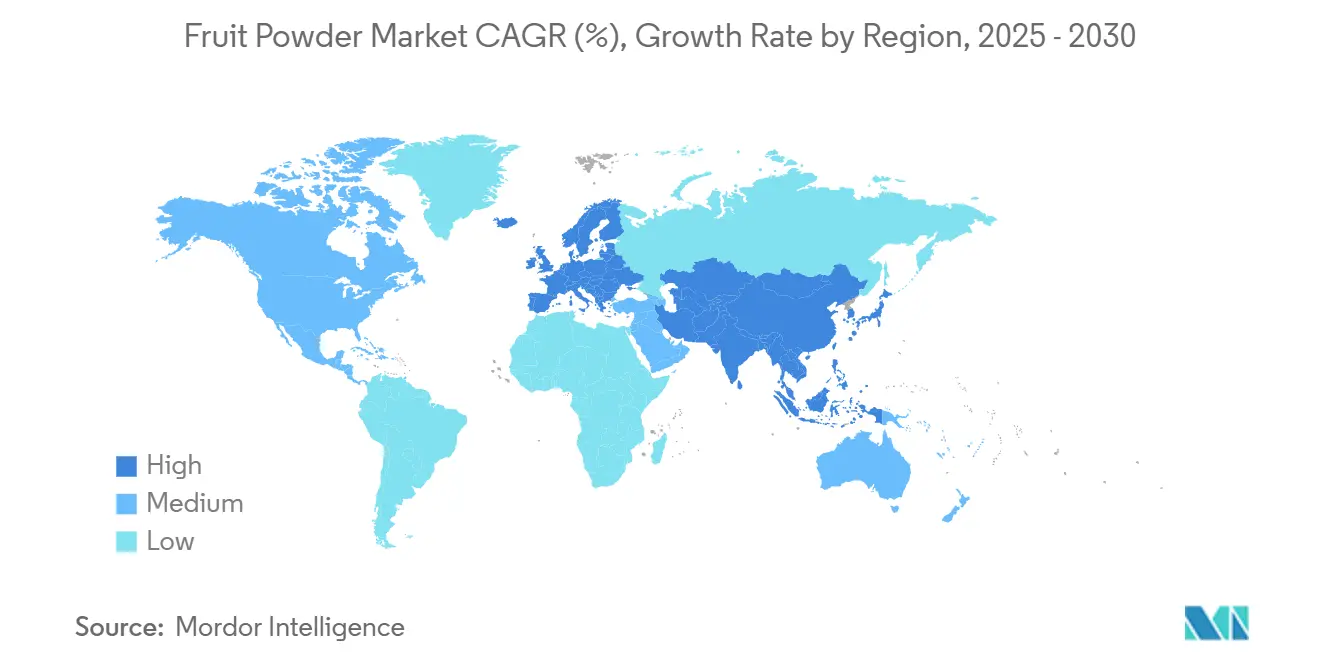
Competitive Landscape
The fruit powder market showcases a fragmented competition landscape. This fragmentation not only opens doors for consolidation but also paves the way for niche specialization strategies. Specialized processors are seizing the chance to target premium segments, while larger food conglomerates are making strategic acquisitions to fortify their integrated supply chains. In a market leaning towards commoditization, major players are carving out their niches through vertical integration, securing organic certifications, and embracing technological innovations. Companies boasting strong regulatory compliance, especially in light of the USDA's Strengthening Organic Enforcement rule, find themselves at an advantage. This rule poses challenges for smaller players who may not have the necessary documentation systems in place.
The competitive landscape is further shaped by the increasing demand for clean-label and organic products, which has driven companies to prioritize transparency and sustainability in their operations. Larger players are leveraging economies of scale to reduce costs and enhance their market presence, while smaller firms are focusing on agility and innovation to cater to evolving consumer preferences. Additionally, the growing popularity of functional foods and beverages has encouraged companies to diversify their product portfolios, incorporating fruit powders with added health benefits to meet consumer demand.
Leading companies are placing a premium on technology adoption and supply chain oversight. They're channeling investments into cutting-edge processing technologies, such as ambient-temperature spray drying. This technology not only curtails energy consumption but also ensures the nutritional content of the products is preserved. Furthermore, advancements in packaging and storage solutions are enabling companies to extend the shelf life of fruit powders, ensuring product quality and reducing waste. These strategic initiatives are helping players maintain a competitive edge in a rapidly evolving market.
Fruit Powder Industry Leaders
-
European Freeze Dry Ltd
-
Döhler Group SE
-
Milne MicroDried Inc.
-
Kanegrade Ltd
-
Thrive Freeze Dry
- *Disclaimer: Major Players sorted in no particular order
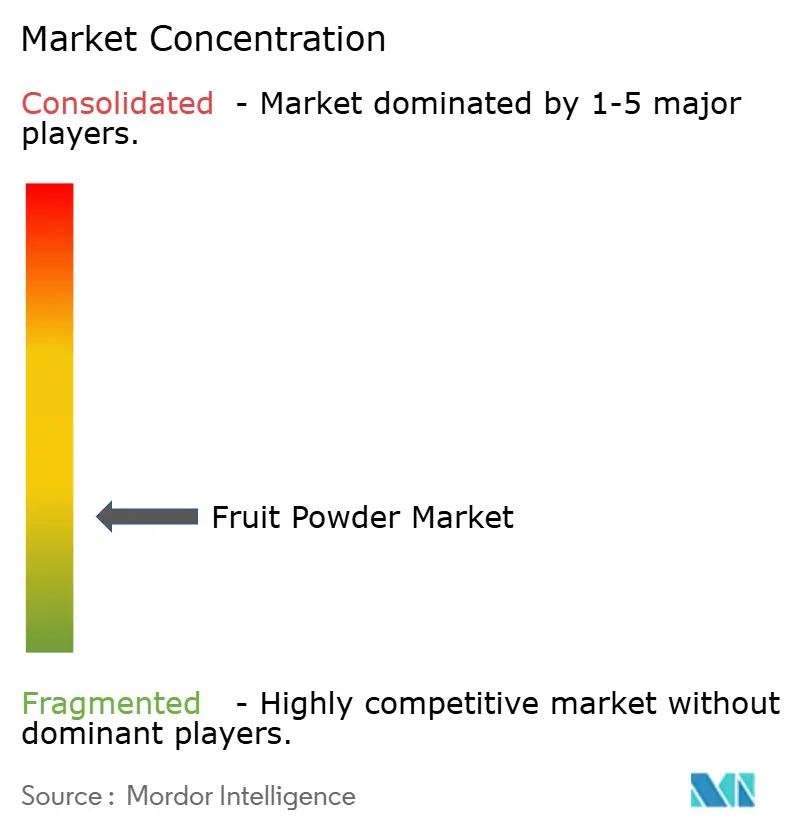
Recent Industry Developments
- February 2025: Dole has partnered with Givaudan to distribute Green Banana Powder, a recycled ingredient developed by Dole Specialty Ingredients (DSI). The collaboration will enhance Givaudan’s Sense Texture range with sustainable emulsifier and texturizer solutions.
- October 2024: Fruit d'Or, a global leader in cultivating and processing premium cranberries and wild blueberries, unveiled Blue d'Or Vitality at SupplySide West 2024. Tailored for the sports nutrition and nutraceutical sectors, Blue d'Or Vitality represents the forefront of clean-label, organic solutions, championing vitality and holistic wellness.
- July 2024: Thrive Freeze Dry, backed by Entrepreneurial Equity Partners and Mubadala Capital, acquired Paradiesfrucht GmbH to strengthen its European market position and expand freeze-dried product capabilities. This acquisition enhances Thrive's product range in freeze-dried fruits and specialized food ingredients while leveraging Paradiesfrucht's sustainability and innovation expertise.
- May 2024: Döhler expanded its Paarl facility in South Africa by adding new production lines for powdered flavors and compounds, including fruit powders, to enhance local processing capabilities.
Research Methodology Framework and Report Scope
Market Definitions and Key Coverage
Mordor Intelligence defines the fruit powder market as the value of commercially manufactured powders produced from 100 % fruit (juice, pulp, or whole fruit) that are dried principally by spray, freeze, drum, or vacuum methods and then sold to food, beverage, nutraceutical, and cosmetic formulators worldwide.
Scope exclusion: Home-made dehydrated fruit flakes and mixed super-food blends containing less than fifty percent fruit content are excluded.
Segmentation Overview
- By Fruit Type
- Apple
- Banana
- Berry
- Strawberry
- Blueberry
- Raspberry
- Citrus
- Mango
- Pineapple
- Dragon Fruit
- Grape
- Other Fruits
- By Category
- Conventional
- Organic
- By Application
- Bakery
- Confectionery
- Dairy and Frozen Desserts
- Snacks/(Ready-to-Eat) RTE Products
- Beverages
- Soups, Sauces and Savoury Mixes
- Other Applications
- By Geography
- North America
- United States
- Canada
- Mexico
- Rest of North America
- Europe
- Germany
- United Kingdom
- Italy
- France
- Spain
- Netherlands
- Sweden
- Poland
- Belgium
- Rest of Europe
- Asia-Pacific
- China
- India
- Japan
- Australia
- Indonesia
- South Korea
- Thailand
- Singapore
- Rest of Asia-Pacific
- South America
- Brazil
- Argentina
- Chile
- Colombia
- Peru
- Rest of South America
- Middle East and Africa
- South Africa
- Saudi Arabia
- United Arab Emirates
- Nigeria
- Egypt
- Morocco
- Turkey
- Rest of Middle East and Africa
- North America
Detailed Research Methodology and Data Validation
Primary Research
Interviews with ingredient distributors, contract spray dryers, beverage R&D managers, and procurement leads across Asia-Pacific, Europe, and North America clarify average selling prices, wastage allowances, and the share of powders moving into clean-label formulations. Follow-up surveys with nutritionists and private-label buyers validate shelf-life premium ranges and forecast adoption of organic lines.
Desk Research
Our analysts first map the global fruit processing landscape by compiling five-year production data from FAOSTAT, UN Comtrade shipment codes (0813, 2008), and USDA Foreign Agricultural Service outlooks. Trade association white papers, such as those from the International Fruit & Vegetable Juice Association, and peer-reviewed journals on nutrient retention in spray drying add technical depth. Company 10-K filings and investor decks reveal installed drying capacities, while paid databases like D&B Hoovers and Dow Jones Factiva help size leading suppliers' revenues and expansion plans. These publicly available and subscription sources anchor baseline assumptions; many additional references are consulted beyond the illustrative list above.
Market-Sizing & Forecasting
A top-down reconstruction starts with raw fruit output, post-harvest loss factors, and typical extraction yields to estimate potential puree volumes, which are then converted to powder tons using technology-specific solid-content ratios. Select bottom-up checks, sampled supplier revenues and regional channel audits, calibrate the totals. Key variables modeled include global banana and berry harvest trends, spray drying operating rates, average export unit prices, new functional beverage launches, and organic powder penetration. Forecasts to 2030 are generated with multivariate regression and scenario analysis, blending macro indicators (GDP per capita, health and wellness spend) with industry fingerprints such as e-commerce shelf counts.
Data Validation & Update Cycle
Outputs undergo variance checks against shipment quantities and retail scan data; anomalies trigger re-contacts with experts before senior review. Reports refresh annually, and interim updates occur when material events, such as crop shocks, regulation shifts, or major capacity additions, alter assumptions. A final analyst pass ensures clients receive the latest calibrated view.
Why Mordor's Fruit Powder Baseline Earns Trust
Published estimates often differ because firms choose unlike product baskets, price ladders, and refresh cadences. By focusing strictly on single-ingredient fruit powders, using live ASP feedback, and updating each year, Mordor delivers a balanced, traceable figure.
Key gap drivers elsewhere include broader inclusion of vegetable powders, reliance on list prices without channel discounts, historical currency bases, and limited primary validation.
Benchmark comparison
| Market Size | Anonymized source | Primary gap driver |
|---|---|---|
| USD 16.23 Bn (2025) | Mordor Intelligence | - |
| USD 54.55 Bn (2024) | Global Consultancy A | Includes vegetable powders and functional blends; uses manufacturer list prices; older exchange rates |
| USD 26.19 Bn (2024) | Trade Journal B | Counts distributor turnover, excludes B2C online sales, minimal primary checks |
Taken together, the comparison shows that Mordor's disciplined scope, dual-stage validation, and annually refreshed assumptions provide decision-makers with a dependable starting point, neither inflated by ancillary categories nor understated by narrow data slices.
Key Questions Answered in the Report
What is the current size of the fruit powder market?
The fruit powder market is valued at USD 16.23 billion in 2025 and is forecast to reach USD 22.01 billion by 2030.
Which region leads global revenue?
Asia-Pacific holds the largest regional share at 35.23% in 2024, supported by dense processing infrastructure and strong export orientation.
Which application segment is growing the fastest?
Snacks and ready-to-eat products post the highest growth at a 7.21% CAGR through 2030 as consumers seek healthier convenience options.
What drives the upswing in exotic fruit powders?
Premiumization trends and consumer interest in antioxidants propel dragon fruit, berry and other exotic powders, which combine visual appeal with functional nutrition.
Page last updated on:
